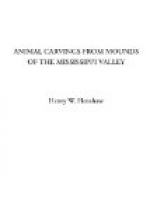[Illustration: Fig. 4.—Otter. From Ancient Monuments.]
Figure 4 is identified by the authors of the “Ancient Monuments” (Fig. 156) as an otter, and few naturalists will hesitate in pronouncing it to be a very good likeness of that animal; the short broad ears, broad head and expanded snout, with the short, strong legs, would seem to belong unmistakably to the otter. Added to all these is the indication of its fish-catching habits. Having thus correctly identified this animal, and with it before them, it certainly reflects little credit upon the zoological knowledge of the authors and their powers of discrimination to refer the next figure (Ancient Monuments, Fig. 157) to the same animal.
[Illustration: Fig. 5.—Otter of Squier and Davis.]
Of a totally different shape and physiognomy, if intended as an otter it certainly implies an amazing want of skill in its author. However it is assuredly not an otter, but is doubtless an unfinished or rudely executed ground squirrel, of which animal it conveys in a general way a good idea, the characteristic attitude of this little rodent, sitting up with paws extended in front, being well displayed. Carvings of small rodents in similar attitudes are exhibited in Stevens’s “Flint Chips,” p. 428, Figs. 61 and 62. Stevens’s Fig. 61 evidently represents the same animal as Fig. 157 of Squier and Davis, but is a better executed carving.
In illustration of the somewhat vague idea entertained by archaeologists as to what the manatee is like, it is of interest to note that the carving of a second otter with a fish in its mouth has been made to do duty as a manatee, although the latter animal is well known never to eat fish, but, on the contrary, to be strictly herbivorous. Thus Stevens gives figures of two carvings in his “Flint Chips,” p. 429, Figs. 65 and 66, calling them manatees, and says: “In one particular, however, the sculptors of the mound-period committed an error. Although the lamantin is strictly herbivorous, feeding chiefly upon subaqueous plants and littoral herbs, yet upon one of the stone smoking-pipes, Fig. 66, this animal is represented with a fish in its mouth.” Mr. Stevens apparently preferred to credit the mound sculptor with gross ignorance of the habits of the manatee, rather than to abate one jot or tittle of the claim possessed by the carving to be considered a representation of that animal. Stevens’s fish-catching manatee is the same carving given by Dr. Rau, in the Archaeological Collection of the United States National Museum, p. 47, Fig. 180, where it is correctly stated to be an otter. This cut, which can scarcely be distinguished from one given by Stevens (Fig. 66), is here reproduced (Fig. 6), together with the second supposed manatee of the latter writer (Fig. 7).
[Illustration: Fig. 6.—Otter of Rau; Manatee of Stevens.]
[Illustration: Fig. 7.—Manatee of Stevens.]




